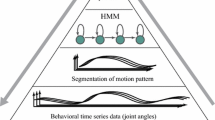Abstract
The complexity of the kinematic and dynamic structure of humanoid robots make conventional analytical approaches to control increasingly unsuitable for such systems. Learning techniques offer a possible way to aid controller design if insufficient analytical knowledge is available, and learning approaches seem mandatory when humanoid systems are supposed to become completely autonomous. While recent research in neural networks and statistical learning has focused mostly on learning from finite data sets without stringent constraints on computational efficiency, learning for humanoid robots requires a different setting, characterized by the need for real-time learning performance from an essentially infinite stream of incrementally arriving data. This paper demonstrates how even high-dimensional learning problems of this kind can successfully be dealt with by techniques from nonparametric regression and locally weighted learning. As an example, we describe the application of one of the most advanced of such algorithms, Locally Weighted Projection Regression (LWPR), to the on-line learning of three problems in humanoid motor control: the learning of inverse dynamics models for model-based control, the learning of inverse kinematics of redundant manipulators, and the learning of oculomotor reflexes. All these examples demonstrate fast, i.e., within seconds or minutes, learning convergence with highly accurate final peformance. We conclude that real-time learning for complex motor system like humanoid robots is possible with appropriately tailored algorithms, such that increasingly autonomous robots with massive learning abilities should be achievable in the near future.
Similar content being viewed by others
References
An, C.H., Atkeson, C., and Hollerbach, J. 1988. Model Based Control of a Robot Manipulator, MIT Press: Cambridge, MA.
Atkeson, C., Moore, A., and Schaal, S. 1997. Locally weighted learning. Artificial Intelligence Review, 11:76–113.
Bishop, C. 1995. Neural Networks for Pattern Recognition, Oxford University Press: London.
Bullock, D., Grossberg, S., and Guenther, F.H. 1993. A selforganizing neural model of motor equivalent reaching and tool use by a multijoint arm. Journal of Cognitive Neuroscience, 5(4): 408–435.
Cruse, H. and Brüwer, M. 1987. The human arm as a redundant manipulator: The control of path and joint angles. Biological Cybernetics, 57:137–144.
Frank, I.E. and Friedman, J.H. 1993. A statistical view of some chemometric regression tools. Technometrics, 35:109–135.
Jordan, M.I. and Rumelhart, D.E. 1992. Supervised learning with a distal teacher. Cognitive Science, 16(3):307–354.
Kawato, M. 1990. Feedback-error-learning neural network for supervised motor learning. In Advanced Neural Computers, R. Eckmiller (Ed.), North-Holland/Elsevier: Amsterdam, pp. 365–372.
Liegeois, A. 1977. Automatic supervisory control of the configuration and behavior of multibody mechnisms. IEEE Transactions on Systems, Man, and Cybernetics, 7(12):868–871.
Ljung, L. and Soderstrom, T. 1986. Theory and Practice of Recursive Identification, MIT Press: Cambridge, MA.
Sanger, T.D. 1989. Optimal unsupervised learning in a single layer liner feedforward neural network. Neural Networks, 2:459–473.
Saunders, C., Stitson, M.O., Weston, J., Bottou, L., Schoelkopf, B., and Smola, A. 1998. Support vector machine—Reference manual. TR CSD-TR–98–03. Department of Computer Science, Royal Holloway, University of London.
Schaal, S. 1999. Is imitation learning the route to humanoid robots? Trends in Cognitive Sciences, 3:233–242.
Schaal, S. and Atkeson, C.G. 1998. Constructive incremental learning from only local information. Neural Comp. 10:2047–2084.
Schaal, S., Atkeson, C.G., and Vijayakumar, S. 2000. Real-time robot learning with locally weighted statistical learning. In Proc. International Conference on Robotics and Automation ICRA2000, pp. 288–293.
Schaal, S., Vijayakumar, S., and Atkeson, C.G. 1998. Local dimensionality reduction. Proc. Neural Information Processing Systems, 10:633–639.
Shibata, T. and Schaal, S. 2001. Biomimetic gaze stabilization based on feedback-error-learning with nonparametric regression networks. Neural Networks, 14(2):201–216.
Slotine, J.E. and Li, W. 1991. Applied Nonlinear Control, Prentice Hall: Englewood cliffs, NJ.
Tevatia, G. and Schaal, S. 2000. Inverse kinematics for humanoid robots. In Proceedings of the International Conference on Robotics and Automation (ICRA2000), San Francisco, CA.
Vapnik, V. 1995. The Nature of Statistical Learning Theory, Springer: New York.
Vijayakumar, S. and Schaal, S. 2000. Locally weighted projection regression: An O(n) algorithm for incremental real time learning in high dimensional space. In Proc. International Conference on Machine Learning ICML2000, pp. 1079–1086.
Wold, H. 1975. Soft modeling with latent variables: The nonlinear iterative partial least squares approach. Perspectives in Probability and Statistics: Papers in Honor of M.S. Bartlett, pp. 114–142. Academic Press: London.
Author information
Authors and Affiliations
Rights and permissions
About this article
Cite this article
Vijayakumar, S., D'souza, A., Shibata, T. et al. Statistical Learning for Humanoid Robots. Autonomous Robots 12, 55–69 (2002). https://doi.org/10.1023/A:1013258808932
Issue Date:
DOI: https://doi.org/10.1023/A:1013258808932




